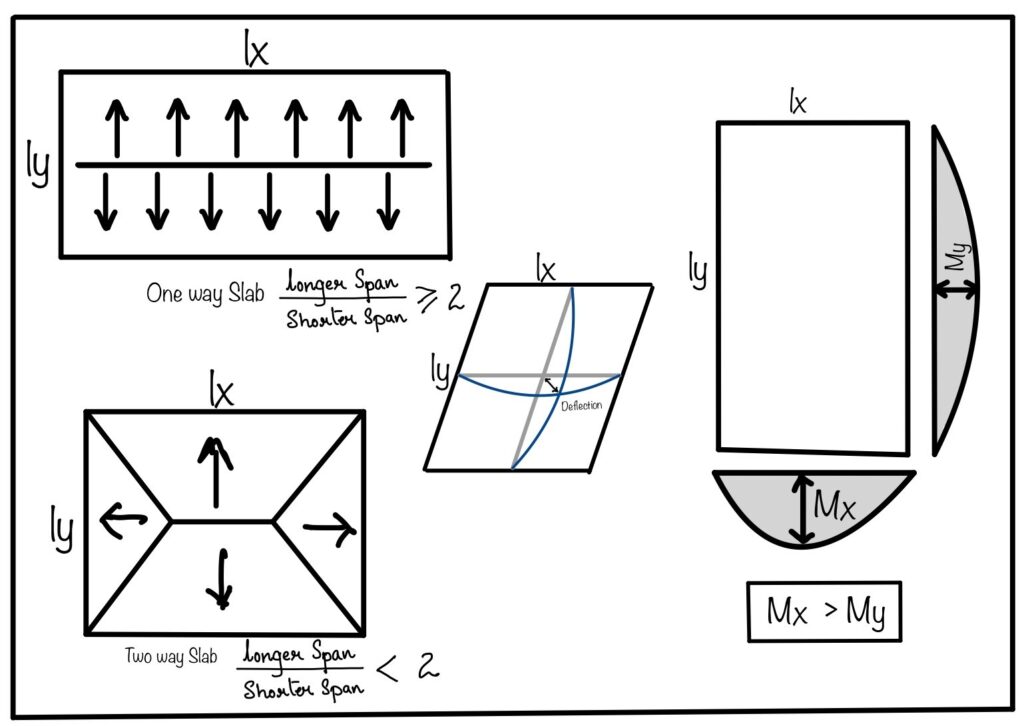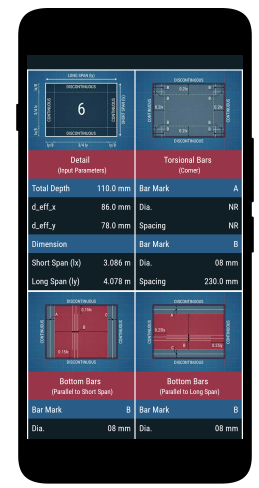Slabs are one of the important structural element of a building. It helps to transfer the various floor loads to the beam, then through columns , last to foundation of structure.
It is defined as the horizontal part of any framed structure, which is supported by RCC beam, masonry wall or by reinforced columns. In the construction phase both the ceiling and floor slabs is considered to be slabs.
For construction, concrete is the widely used material because of its own efficiency. Steel is used as the reinforcement, so as to resist the loads which are coming over it.
Don’t you think it is very important to have knowledge about slabs and its different types.
My answer would be a “Yes”
It is very important to know what is a slab
But it is not necessary to know the type of slab (one- way or two way slab), if you are using any Finite Element Software to Analyze and Design the reinforcement required for the slab.
Weather it is one way or two slab only matters if we are doing
HAND CALCULATIONS……….

A Thumb Rule
One Way Slabs
In simple words one way slab are those slabs which carries the load in only one direction.
If the ratio of lengths in two direction is greater than or equal to two
we design the slab as an one- way slab.
$$ \frac{longer\, span}{shorter\, span} > 2 $$
One way slab is supported in two opposite directions.
Span of slab is the shortest side of slab, along which the load transfer occurs.
One way slabs are designed in only one direction i.e., along the span direction.
One way slab deflects in a shape similar to a cylinder.
Reinforcement bars are designed and main tension reinforcement are placed along the length of span .
Minimum reinforcement is provided along the transverse direction to take care of stresses which is due to shrinkage and temperature changes. This minimum reinforcement is also called as secondary reinforcement or distribution steel.
Distribution steel transfers the load transversely over a larger area and thus reducing the effect of stresses due to shrinkage and temperature cracks.
Two Way Slabs
Two way slab is a slab, which transfers the load in both the directions and beams supports on all the four sides.
If the ratio of lengths in two direction is less than two
we design the slab as a two – way slab.
$$ \frac{longer\, span}{shorter\, span} < 2 $$
The main difference from the one way slab is that in two way slab main tension reinforcement is along both the directions, as the transfer of load is along both the directions.
The deflection of a two way slab is like a cup as it is supported from all the four sides.
Now you must be thinking why this 2 ???
In our mind when we look these types of relations, it is very important to ask such questions which will bring curiosity and helps to read more about the particular topic….
I will try to explain my understanding, hope this will help you as well..
Let us take an example of a general slab and the loading is UDL, so the displacement along each direction should be equal,
i.e: $$ \frac{C W_x {l_x}^4}{EI} = \frac{C W_y {l_y}^4}{EI} $$
$$ W_x {l_x}^4 = W_y {l_y}^4$$
$$ W_x = \frac{{l_y}^4}{{l_x}^4}W_y $$
Where,
Wx and Wy are the load along the x axis and y axis respectively.
lx and ly are the span of slab along the x axis and y axis respectively.
Compute the ratio of Wx and Wy for different values of lx and ly,
When the value of $$\frac {l_y}{l_x} =2 $$ there is a significant amount of dominance in the load share by x axis (shorter span), so for design purpose one should consider it as an one-way slab.
When the value of $$\frac {l_y}{l_x} <2 $$, the load is shared by both the directions beam in a significant range so while designing one should design consider the slab as a two way slab.
Curvature
Yes, you read it correctly . Curvature is also one of the parameter which helps in differentiating a slab into one way or two way slab.
$$\frac{M}{I} = \frac{E}{R}$$
$$\frac{M}{EI} = \frac{1}{R}$$
Where,
1/R is the curvature , which is directly proportional to the Bending moment M
Let us take the example of one way slab, where the longer span is approximately double or more than double of the shorter span.
As shown in figure, the curvature for shorter span is less than that of longer span and hence the bending moment (Mx) along the shorter span is greater than the value of bending moment (My) along the longer span.
Therefore, in one way slab reinforcement is designed only for one direction and a transverse minimum reinforcement is provided along the longer span.
But, when we consider a two way slab, the curvature is quite significant for both the directions and thus the value of bending moment will also be significant and it demands proper designing of reinforcement along both the directions.
So, Yes there are different approaches which have to be explored more to have a in depth knowledge about the slabs…
If you want to design a RCC slab in just few minutes, then yes here is the solution….
Use this Application…. which makes your work easier and simpler…
Slab design
- RCC Slab Design is a free app for designing one way and two way reinforced concrete slab systems as per Indian Standards.
- RCC Design and detailing could be performed for ten different boundary conditions specified in IS456:2000
- Option to save the design projects in local storage.
- Detailed calculation steps presented for verification and validation.
